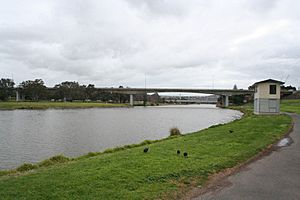James Harrison (engineer) facts for kids
Quick facts for kids
James Harrison
|
|
|---|---|
| Born | 17 April 1816 Bonhill, Dunbartonshire, Scotland
|
| Died | 3 September 1893 (aged 77) |
| Occupation | Engineer and politician |
| Known for | Refrigeration |
James Harrison (born April 17, 1816 – died September 3, 1893) was a Scottish engineer and politician. He was a true pioneer in the world of mechanical refrigeration.
Harrison started the Geelong Advertiser newspaper in Victoria, Australia. He also served as a member of the local government, in the Victorian Legislative Council and Victorian Legislative Assembly. He is best known for inventing the mechanical refrigeration process that makes ice. Because of this, he is often called "the father of refrigeration." In 1873, he won a gold medal at the Melbourne Exhibition. He proved that meat kept frozen for months could still be perfectly good to eat.
Contents
Early Life and Newspaper Work
James Harrison was born in Bonhill, Scotland. His father was a fisherman. James studied chemistry at Anderson's University and the Glasgow Mechanics' Institution. He learned to be a printer in Glasgow. Later, he worked in London.
In 1837, he moved to Sydney, Australia. He helped set up a printing press there. In 1839, he moved to Melbourne. He worked for John Pascoe Fawkner at the Port Phillip Patriot newspaper.
Harrison bought an old printing press from Fawkner. He used it to start Geelong's very first newspaper. The first weekly edition of the Geelong Advertiser came out in November 1840. By November 1842, Harrison owned the newspaper all by himself.
Political Career and New Ideas
Harrison became a member of Geelong's first town council in 1850. He represented Geelong in the Victorian Legislative Council from 1854 to 1856. After that, he represented Geelong (1858–59) and Geelong West (1859–60) in the Victorian Legislative Assembly.
As a newspaper editor, he supported ideas like tariff protection. This meant making imported goods more expensive to help local businesses. He later became editor of The Age newspaper.
In 1854, Harrison faced a difficult legal case. He had written about a public official in his newspaper. This led to him having to pay a large amount of money. In 1862, even though he had many valuable things, he had to sell the Advertiser. This helped him avoid serious financial trouble.
While he owned the newspaper, he became very interested in refrigeration and making ice. He noticed that when he cleaned printing type with a liquid called ether, the evaporating liquid made the metal feel very cold. This gave him an idea!
Making Ice and Later Life
Harrison's first machine to make ice started working in 1851. It was located on the Barwon River in Geelong.
Before Harrison's invention, ice had to be shipped from places like the United States and Norway. This was very expensive. Harrison's machine offered a much cheaper way to get ice in Australia. His first machine for selling ice came out in 1854. He also got a patent for his ether refrigeration system in 1855.
This new system used a compressor. It pushed a special gas through a condenser, which cooled the gas down until it turned into a liquid. This liquid then flowed through cooling coils. As it turned back into a gas, it made the area around it very cold. His machine had a large 5-meter (16-foot) wheel. It could make 3,000 kilograms (6,600 pounds) of ice every day!
In 1856, Harrison went to London. He patented both his ice-making process and his machine there. That same year, a brewery asked him to build a machine to cool beer. His system quickly became popular in breweries. Meatpacking factories also started using it a lot.
Harrison had success with a second ice company in Sydney in 1860. He then thought about how Australia could send refrigerated meat to the United Kingdom. In 1873, he prepared a ship called the Norfolk for an experiment. He tried to send beef to the United Kingdom in a cold room filled with ice. However, the ice melted faster than expected. The experiment failed, and people lost trust in sending refrigerated meat for a while.
After this, he went back to journalism. He became the editor of the Melbourne Age newspaper in 1867.
Harrison returned to Geelong in 1892. He passed away at his home in Point Henry in 1893.
Legacy

A group called the James Harrison Museum committee has bought land at Rocky Point. This is where the world's first ice-making machine was located. They are working to build a museum there.
The Australian Institute of Refrigeration Air Conditioning and Heating gives out its most important award, the James Harrison Medal, in his honor.
The James Harrison bridge, which crosses the Barwon River in Geelong, is named after him.
A special plaque in Melbourne marks the Victoria Ice Works. James Harrison founded this company in 1859.
In 1956, a plaque was placed in Ryrie Street, Geelong. It celebrated 100 years since his refrigeration invention.
See also
- Klaas Visser - A Dutch Australian inventor who created modern refrigeration and freezer solutions. He won many awards, including the James Harrison Medal.
- John Gorrie - An American doctor and inventor, another early pioneer of refrigeration.
- Thomas Sutcliffe Mort - Another Australian refrigeration pioneer. He helped finance the work of engineer Eugene Dominic Nicolle.
- Jacob Perkins - An American inventor who patented an ether cycle machine in 1836.
- Alexander Twining - An American who patented a similar machine in 1850 and 1853.

